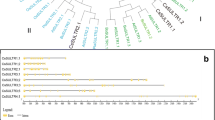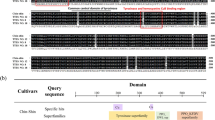Abstract
Tea (Camellia sinensis L.) contains secondary metabolites including polyphenolic proanthocyanidins (PAs) and their precursors. The SCPL (serine carboxypeptidase-like) proteins are a group of acyltransferase enzymes that modify plant natural products. We isolated CsSCPL, which encodes a SCPL protein, from oolong tea. Sequence alignment analyses showed that CsSCPL is a serine carboxypeptidase with high homology to other SCPLs, including those in persimmon, grape, woodland strawberry, and sweet orange. Quantitative RT-PCR analyses revealed that the highest transcript levels of CsSCPL were in young leaves of tea seedlings and buds of mature plants. CsSCPL transcription increased in response to heat but decreased in response to cold, high salinity, and drought. The degree of epigallocatechin galloylation increased after heat treatment and the degree of epicatechin galloylation decreased after cold treatment. In field-grown tea plants, the highest transcript levels of CsSCPL were in summer. Together, these results show that CsSCPL transcripts accumulate in one-tip-two-leaf tissues of oolong tea plants during the hottest parts of the growing season, and in response to abiotic stress. The degree of catechin galloylation was positively correlated with CsSCPL transcript levels after heat or cold treatments. Our results will be useful for further research on the functions of SCPLs in plants.




Similar content being viewed by others
References
Astill C, Birch MR, Dacombe C, Humphrey PG, Martin PT (2001) Factors affecting the caffeine and polyphenol contents of black and green tea infusions. J Agric Food Chem 49(11):5340–5347
Bizjak J, Weber N, Mikulic-Petkovsek M, Alam Z, Thill J, Stich K, Halbwirth H, Veberic R (2013) Polyphenol gene expression and changes in anthocyanins and polyphenols in the skin of ‘Braeburn’ apples after the autumn application of prohexadione-calcium. Plant Growth Regul 71(3):225–233
Buer CS, Sukumar P, Muday GK (2006) Ethylene modulates flavonoid accumulation and gravitropic responses in roots of Arabidopsis. Plant Physiol 140(4):1384–1396
Buer CS, Muday GK, Djordjevic MA (2007) Flavonoids are differentially taken up and transported long distances in Arabidopsis. Plant Physiol 145(2):478–490
Chen GH, Yang CY, Lee SJ, Wu CC, Tzen JTC (2014) Catechin content and the degree of its galloylation in oolong tea were inversely correlated with cultivation altitude. J Food Drug Anal 22:303–309
Das A, Das S, Mondal TK (2012) Identification of Differentially expressed gene profiles in young roots of tea [Camellia sinensis (L.) O. Kuntze] subjected to drought stress using suppression subtractive hybridization. Plant Mol Biol Rep 30(5):1088–1101
Debeaujon I, Leon-Kloosterziel KM, Koornneef M (2000) Influence of the testa on seed dormancy, germination, and longevity in Arabidopsis. Plant Physiol 122(2):403–414
Deng WW, Fei Y, Wang S, Wan XC, Zhang ZZ, Hu XY (2013) Effect of shade treatment on theanine biosynthesis in Camellia sinensis seedlings. Plant Growth Regul 71(3):295–299
Eungwanichayapant PD, Popluechai S (2009) Accumulation of catechins in tea in relation to accumulation of mRNA from genes involved in catechin biosynthesis. Plant Physiol Biochem 47(2):94–97
Feng Y, Xue Q (2006) The serine carboxypeptidase like gene family of rice (Oryza sativa L. ssp. japonica). Funct Integr Genomics 6(1):14–24
Fraser CM, Rider LW, Chapple C (2005) An expression and bioinformatics analysis of the Arabidopsis serine carboxypeptidase-like gene family. Plant Physiol 138(2):1136–1148
Fujita A, Soma N, Goto-Yamamoto N, Shindo H, Kakuta T, Koizumi T, Hashizume K (2005) Anthocyanidin reductase gene expression and accumulation of flavan-3-ols in grape berry. Am J Enol Viticult 56(4):336–342
Hayashi N, Chen R, Hiraoka M, Ujihara T, Ikezaki H (2010) Beta-cyclodextrin/surface plasmon resonance detection system for sensing bitter-astringent taste intensity of green tea catechins. J Agric Food Chem 58(14):8351–8356
Hermsmeier D, Schittko U, Baldwin IT (2001) Molecular interactions between the specialist herbivore Manduca sexta (Lepidoptera, Sphingidae) and its natural host Nicotiana attenuata. I. Large-scale changes in the accumulation of growth- and defense-related plant mRNAs. Plant Physiol 125(2):683–700
Ikegami A, Eguchi S, Kitajima A, Inoue K, Yonemori K (2007) Identification of genes involved in proanthocyanidin biosynthesis of persimmon (Diospyros kaki) fruit. Plant Sci 172(5):1037–1047
Jiang X, Liu Y, Li W, Zhao L, Meng F, Wang Y, Tan H, Yang H, Wei C, Wan X, Gao L, Xia T (2013) Tissue-specific, development-dependent phenolic compounds accumulation profile and gene expression pattern in tea plant [Camellia sinensis]. PLoS One 8(4):e62315
Kondo S, Fiebig A, Okawa K, Ohara H, Kowitcharoen L, Nimitkeatkai H, Kittikorn M, Kim M (2011) Jasmonic acid, polyamine, and antioxidant levels in apple seedlings as affected by ultraviolet-C irradiation. Plant Growth Regul 64(1):83–89
Kyte J, Doolittle RF (1982) A simple method for displaying the hydropathic character of a protein. J Mol Biol 157(1):105–132
Lehfeldt C, Shirley AM, Meyer K, Ruegger MO, Cusumano JC, Viitanen PV, Strack D, Chapple C (2000) Cloning of the SNG1 gene of Arabidopsis reveals a role for a serine carboxypeptidase-like protein as an acyltransferase in secondary metabolism. Plant Cell 12(8):1295–1306
Li AX, Steffens JC (2000) An acyltransferase catalyzing the formation of diacylglucose is a serine carboxypeptidase-like protein. Proc Natl Acad Sci USA 97(12):6902–6907
Liu H, Wang X, Zhang H, Yang Y, Ge X, Song F (2008) A rice serine carboxypeptidase-like gene OsBISCPL1 is involved in regulation of defense responses against biotic and oxidative stress. Gene 420(1):57–65
Liu Y, Gao L, Liu L, Yang Q, Lu Z, Nie Z, Wang Y, Xia T (2012) Purification and characterization of a novel galloyltransferase involved in catechin galloylation in the tea plant (Camellia sinensis). J Biol Chem 287(53):44406–44417
Milkowski C, Strack D (2004) Serine carboxypeptidase-like acyltransferases. Phytochemistry 65(5):517–524
Mugford ST, Milkowski C (2012) Serine carboxypeptidase-like acyltransferases from plants. Methods Enzymol 516:279–297
Mugford ST, Osbourn A (2010) Evolution of serine carboxypeptidase-like acyltransferases in the monocots. Plant Signal Behav 5(2):193–195
Mugford ST, Qi X, Bakht S, Hill L, Wegel E, Hughes RK, Papadopoulou K, Melton R, Philo M, Sainsbury F, Lomonossoff GP, Roy AD, Goss RJ, Osbourn A (2009) A serine carboxypeptidase-like acyltransferase is required for synthesis of antimicrobial compounds and disease resistance in oats. Plant Cell 21(8):2473–2484
Mujib A, Ilah A, Aslam J, Fatima S, Siddiqui ZH, Maqsood M (2012) Catharanthus roseus alkaloids: application of biotechnology for improving yield. Plant Growth Regul 68(2):111–127
Pang Y, Abeysinghe IS, He J, He X, Huhman D, Mewan KM, Sumner LW, Yun J, Dixon RA (2013) Functional characterization of proanthocyanidin pathway enzymes from tea and their application for metabolic engineering. Plant Physiol 161(3):1103–1116
Park JS, Kim JB, Hahn BS, Kim KH, Ha SH, Kim JB, Kim YH (2004) EST analysis of genes involved in secondary metabolism in Camellia sinensis (tea), using suppression subtractive hybridization. Plant Sci 166(4):953–961
Perva-Uzunalic A, Skerget M, Knez Z, Weinreich B, Otto F, Gruner S (2006) Extraction of active ingredients from green tea (Camellia sinensis): extraction efficiency of major catechins and caffeine. Food Chem 96(4):597–605
Petroni K, Tonelli C (2011) Recent advances on the regulation of anthocyanin synthesis in reproductive organs. Plant Sci 181(3):219–229
Saeid ZD, Zahra A, Abdolhamid NS (2014) Investigation of synergistic action between coronatine and nitric oxide in alleviating arsenic-induced toxicity in sweet basil seedlings. Plant Growth Regul 74(2):119–130
Saitou N, Nei M (1987) The neighbor-joining method: a new method for reconstructing phylogenetic trees. Mol Biol Evol 4(4):406–425
Shirley AM, McMichael CM, Chapple C (2001) The sng2 mutant of Arabidopsis is defective in the gene encoding the serine carboxypeptidase-like protein sinapoylglucose:choline sinapoyltransferase. Plant J 28(1):83–94
Shulaev V, Sargent DJ, Crowhurst RN, Mockler TC, Folkerts O, Delcher AL, Jaiswal P, Mockaitis K, Liston A, Mane SP, Burns P, Davis TM, Slovin JP, Bassil N, Hellens RP, Evans C, Harkins T, Kodira C, Desany B, Crasta OR, Jensen RV, Allan AC, Michael TP, Setubal JC, Celton JM, Rees DJ, Williams KP, Holt SH, Ruiz Rojas JJ, Chatterjee M, Liu B, Silva H, Meisel L, Adato A, Filichkin SA, Troggio M, Viola R, Ashman TL, Wang H, Dharmawardhana P, Elser J, Raja R, Priest HD, Bryant DW Jr, Fox SE, Givan SA, Wilhelm LJ, Naithani S, Christoffels A, Salama DY, Carter J, Lopez Girona E, Zdepski A, Wang W, Kerstetter RA, Schwab W, Korban SS, Davik J, Monfort A, Denoyes-Rothan B, Arus P, Mittler R, Flinn B, Aharoni A, Bennetzen JL, Salzberg SL, Dickerman AW, Velasco R, Borodovsky M, Veilleux RE, Folta KM (2011) The genome of woodland strawberry (Fragaria vesca). Nat Genet 43(2):109–116
Stehle F, Brandt W, Stubbs MT, Milkowski C, Strack D (2009) Sinapoyltransferases in the light of molecular evolution. Phytochemistry 70(15–16):1652–1662
Tamura K, Stecher G, Peterson D, Filipski A, Kumar S (2013) MEGA6: molecular evolutionary genetics analysis version 6.0. Mol Biol Evol 30(12):2725–2729
Terrier N, Torregrosa L, Ageorges A, Vialet S, Verries C, Cheynier V, Romieu C (2009) Ectopic expression of VvMybPA2 promotes proanthocyanidin biosynthesis in grapevine and suggests additional targets in the pathway. Plant Physiol 149(2):1028–1041
Treutter D (2005) Significance of flavonoids in plant resistance and enhancement of their biosynthesis. Plant Biol (Stuttg) 7(6):581–591
Xu Q, Chen LL, Ruan X, Chen D, Zhu A, Chen C, Bertrand D, Jiao WB, Hao BH, Lyon MP, Chen J, Gao S, Xing F, Lan H, Chang JW, Ge X, Lei Y, Hu Q, Miao Y, Wang L, Xiao S, Biswas MK, Zeng W, Guo F, Cao H, Yang X, Xu XW, Cheng YJ, Xu J, Liu JH, Luo OJ, Tang Z, Guo WW, Kuang H, Zhang HY, Roose ML, Nagarajan N, Deng XX, Ruan Y (2013) The draft genome of sweet orange (Citrus sinensis). Nat Genet 45(1):59–66
Acknowledgments
The authors thank Mr. Jian-Syun Chen for his generous supply of tea plants. This work was supported by a grant from the National Science Council, Taiwan, R.O.C. (NSC 103-2313-B-005-006).
Author's Contributions
The work presented here was carried out in collaboration between all authors. Dr. Jason T. C. Tzen and Dr. Chin-Ying Yang collaboration defined the research theme, designed experiments and analyzed the data. Dr. Chin-Ying Yang wrote the manuscript. Chih-Hao Chiu carried out the experiments and analyzed the data. Guan-Heng Chen carried out the HPLC analysis.
Author information
Authors and Affiliations
Corresponding authors
Rights and permissions
About this article
Cite this article
Chiu, CH., Chen, GH., Tzen, J.T.C. et al. Molecular identification and characterization of a serine carboxypeptidase-like gene associated with abiotic stress in tea plant, Camellia sinensis (L.). Plant Growth Regul 79, 345–353 (2016). https://doi.org/10.1007/s10725-015-0138-7
Received:
Accepted:
Published:
Issue Date:
DOI: https://doi.org/10.1007/s10725-015-0138-7




